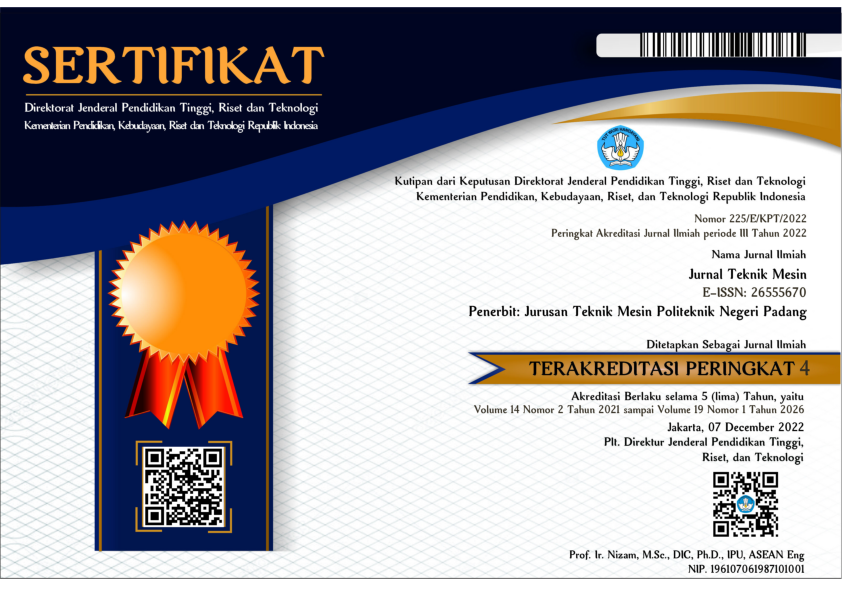Isoterm Adsorpsi Arang Kulit Jengkol Sebagai Adsorben CO2
Abstract
The concentration of carbon dioxide (CO2) gas in the atmosphere continues to increase every year, mainly due to human activities such as burning fossil fuels for energy, industrial processes, and transportation. The development of CO2 gas reduction research continues to be carried out, one of which is the adsorption process using adsorbents. The research was carried out by looking at the effect of variations in activating agent and activation temperature on adsorbents as CO2 adsorbers and how N2 and pore size distribution influence CO2 adsorption. The active carbon adsorbent used comes from jengkol peel which is carbonized via the pyrolysis method. Adsorbents are made by varying the type of activating material (KOH, Urea, and KOH+urea) and activation temperature (600℃, 700℃, and 800℃). The active ingredient KOH+urea has better absorption capacity than other variations, but not too high. N2 gas does not really affect the CO2 adsorption process because it has a low N2 adsorption isotherm, so it is not worrying if the CO2 adsorption process also contains N2 in the air. Based on measurements with Belsorp-Max II, the data obtained is only specific surface area data, this is due to the small surface pores of the adsorbent. The temperature of 800℃ has a better specific surface area than other variations, this is also by the higher CO2 adsorption capacity. So it is concluded that the pore surface area influences the ability to absorb CO2. Based on the data obtained, jengkol peel charcoal is not suitable as a CO2 adsorbent because it has a low pore surface area and adsorption isotherm
References
for CO2 capture application under mild condition: A review, J Environ Chem Eng, vol. 7, no. 2, p. 103022, Apr. 2019, doi: 10.1016/j.jece.2019.103022.
F. F. Zaemi and R. C. Rohmana, Carbon Capture, Utilization, and Storage (CCUS) untuk Pembangunan Berkelanjutan: Potensi dan Tantangan di Industri Migas Indonesia, 2021.
P. D. Dissanayake, S. You, A. D. Igalavithana, and Y. Xia, Biochar-based adsorbents for carbon dioxide capture, Renewable and Sustainable Energy Reviews, vol. 119, no. 119, Mar. 2020, doi: 10.1016/j.rser.2019.109582.
W. Hao, E. Björkman, M. Lilliestråle, and N. Hedin, Activated carbons prepared from hydrothermally carbonized waste biomass used as adsorbents for CO2, Appl Energy, vol. 112, pp. 526–532, Dec. 2013, doi: 10.1016/j.apenergy.2013.02.028.
X. Zhang, Y. Huang, H. Gao, X. Luo, Z. Liang, and P. Tontiwachwuthikul, Zeolite catalyst-aided tri-solvent blend amine regeneration: An alternative pathway to reduce the energy consumption in amine-based CO2 capture process, Appl Energy, vol. 240, pp. 827–841, Apr. 2019, doi: 10.1016/j.apenergy.2019.02.089.
M. Mohamedali, D. Nath, H. Ibrahim, and A. Henni, Review of Recent Developments in CO2 Capture Using Solid Materials: Metal Organic Frameworks (MOFs), Greenhouse Gases, pp. 115–154, Mar. 2016, doi: 10.5772/62275.
Z. H. Lee, K. T. Lee, S. Bhatia, and A. R. Mohamed, Post-combustion carbon dioxide capture: Evolution towards utilization of nanomaterials, Renewable and Sustainable Energy Reviews, vol. 16, no. 5, pp. 2599–2609, Jun. 2012, doi: 10.1016/j.rser.2012.01.077.
B. Petrovic, M. Gorbounov, and S. Masoudi Soltani, Influence of surface modification on selective CO2 adsorption: A technical review on mechanisms and methods, Microporous and Mesoporous Materials, vol. 312, p. 110751, Jan. 2021, doi: 10.1016/j.micromeso.2020.110751.
C. H. Yu, C. H. Huang, and C. S. Tan, A review of CO2 capture by absorption and adsorption, Aerosol Air Qual Res, vol. 12, no. 5, pp. 745–769, Oct. 2012, doi: 10.4209/aaqr.2012.05.0132.
H. Fauza, I. Ferita, and N. E. Putri, Studi awal penampilan fenotipik plasma nutfah jengkol (Pithecollobium jiringa) di Padang, Sumatera Barat, in Pros Semnas Masy Biodiv Indon, Padang: Masyarakat Biodiversitas Indonesia, Mar. 2015. doi: 10.13057/psnmbi/m010104.
S. Pandia and B. Warman, Pemanfaatan Kulit Jengkol Sebagai Adsorben Dalam Penyerapan Logam Cd (II) Pada Limbah Cair Industri Pelapisan Logam, Jurnal Teknik Kimia USU, vol. 5, no. 4, p. 57, 2016.
D. Bednarska and M. Koniorczyk, Comparison of various methods applied in porous materials microstructure analysis in regard to hardened cement paste, MATEC Web of Conferences, vol. 282, no. 02043, 2019, doi: 10.1051/matecconf/201928.
G. Yin, Q. Liu, Z. Liu, and W. Wu, Extension of Kelvin equation to CO2 adsorption in activated carbon, Fuel Processing Technology, vol. 174, pp. 118–122, Jun. 2018, doi: 10.1016/j.fuproc.2018.02.006.
R. A. Rasyid, Erdawati, and D. Darwis, Pengaruh Penambahan Biokar Sekam Padi Terhadap Penyerapan Gas CO2 (Carbon Dioxide) Dan Kuat Tekan Pada Plester Dinding, JRSKT - Jurnal Riset Sains dan Kimia Terapan, vol. 8, no. 1, pp. 10–22, Oct. 2019, doi: 10.21009/jrskt.081.02.
A. Gao, N. Gua, M. Yan, M. Li, and F. Wang, Hierarchical porous carbon activated by CaCO3 from pigskin collagen for CO2 and H2 adsorption, Micropor, Mesopor. Mat, vol. 260, pp. 172–179, 2018.
H. Wei, S. Deng, B. Hu, and Z. Chen, Granular Bamboo-Derived Activated Carbon for High CO2 Adsorption, The Dominant Role of Narrow Micropores, ChemSusChem, vol. 5, no. 12, pp. 2354–2360, 2012, doi: 10.1002/cssc.201200570.
P. Zhang et al., A new choice of polymer precursor for solvent-free method: Preparation of N-enriched porous carbons for highly selective CO2 capture, Chemical Engineering Journal, vol. 355, pp. 963–973, Jan. 2019, doi: 10.1016/j.cej.2018.08.219.
A. Rehman and S. J. Park, Tunable nitrogen-doped microporous carbons: Delineating the role of optimum pore size for enhanced CO2 adsorption, Chemical Engineering Journal, vol. 362, pp. 731–742, Apr. 2019, doi: 10.1016/j.cej.2019.01.063.
X. Suo, L. Xia, Q. Yang, and Z. Zhang, Synthesis of anion-functionalized mesoporous poly (ionic liquid)s via a microphase separation-hypercrosslinking strategy: highly efficient adsorbents for bioactive molecules, J. Mater. Chem. A, vol. 5, no. 27, pp. 14114–14123, 2017, doi: 10.1039/C7TA01986F.













